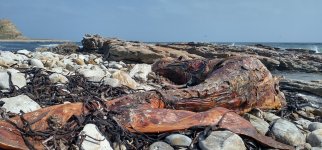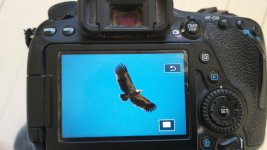
With the entire trip planned around a unique voyage into the Southern Oceans, I will also extend my time in South Africa to spend a couple of weeks in the magical Kruger National Park and surrounding areas.
Part A. Flock to Marion
Flock to Marion, an eight-day pelagic to the wilds of the Southern Oceans in search of birds whose very names evoke mystic and mouthwatering lust … Light-mantled Sooty Albatrosses, King Penguins, Kerguelen Petrels, Antarctic Prions. Travelling into sub-Antarctic waters 1500 km south of the African continent, passing into the infamous roaring 40s with the frequent gales and temperatures little above freezing, this was truly an amazing opportunity to enter the realm of the seabirds.
In the era of Covid however, it also seemed destined to be very much an impossible voyage - the plan was to be eight days on an MSC cruise ship with up to 1700 birders from around the world. Hmm, cruise ships and Covid, madness or blind optimism? Umpteen hurdles and a risk of the whole thing collapsing right up to and beyond the moment of departure, this was indeed an experience even before leaving port!
Originally scheduled for 2020, but postponed due to Covid, everything seemed to be conspiring against this trip happening on the new date of 24 January 2022. After considerable uncertainty whether MSC would even resume cruises in the 2021/2022 season, things looked a little more promising when they did indeed start cruises in early December, even if announcing change of ship several times and flip flopping over the requirements for vaccination and testing.
Then Omicron arrived! A mass Covid outbreak on the maiden cruise of the season saw MSC immediately suspend the season, then most of the world banned flights to South Africa, added the country to red lists and, both in South Africa and elsewhere, the prospect of renewed lockdowns loomed … odds of this trip happening looked bleak.
Planning to fly into South Africa in December, the inevitable happened and my ticket was cancelled three days before departure. I went to the Canary Islands instead. However, as the blight of Omicron began to strangle Europe in early January, things looked more optimistic in South Africa - as case numbers dropped, MSC announced the cruise would take place, albeit with heightened health regulations. Far from confident it would really happen, while still on Fuerteventura, I bought a new flight ticket ...I just had to cross my fingers that (a) MSC didn't suspend the season again following another Covid outbreak on one of its cruises, (b) there were no sudden changes in travel regulations in either Europe or South Africa and (c) that I would not test positive to any of the three Covid tests now required to get on board (PCR to get into South Africa, PCR in the 48 hours before departure and an antigen test at the port immediately before boarding).
Fortunately all worked out, although there was a final unexpected issue, I write this at 5.00 am on the first night as we steam south on route to the Southern Oceans. So to the story, see below:
Part A. Flock to Marion
Flock to Marion, an eight-day pelagic to the wilds of the Southern Oceans in search of birds whose very names evoke mystic and mouthwatering lust … Light-mantled Sooty Albatrosses, King Penguins, Kerguelen Petrels, Antarctic Prions. Travelling into sub-Antarctic waters 1500 km south of the African continent, passing into the infamous roaring 40s with the frequent gales and temperatures little above freezing, this was truly an amazing opportunity to enter the realm of the seabirds.
In the era of Covid however, it also seemed destined to be very much an impossible voyage - the plan was to be eight days on an MSC cruise ship with up to 1700 birders from around the world. Hmm, cruise ships and Covid, madness or blind optimism? Umpteen hurdles and a risk of the whole thing collapsing right up to and beyond the moment of departure, this was indeed an experience even before leaving port!
Originally scheduled for 2020, but postponed due to Covid, everything seemed to be conspiring against this trip happening on the new date of 24 January 2022. After considerable uncertainty whether MSC would even resume cruises in the 2021/2022 season, things looked a little more promising when they did indeed start cruises in early December, even if announcing change of ship several times and flip flopping over the requirements for vaccination and testing.
Then Omicron arrived! A mass Covid outbreak on the maiden cruise of the season saw MSC immediately suspend the season, then most of the world banned flights to South Africa, added the country to red lists and, both in South Africa and elsewhere, the prospect of renewed lockdowns loomed … odds of this trip happening looked bleak.
Planning to fly into South Africa in December, the inevitable happened and my ticket was cancelled three days before departure. I went to the Canary Islands instead. However, as the blight of Omicron began to strangle Europe in early January, things looked more optimistic in South Africa - as case numbers dropped, MSC announced the cruise would take place, albeit with heightened health regulations. Far from confident it would really happen, while still on Fuerteventura, I bought a new flight ticket ...I just had to cross my fingers that (a) MSC didn't suspend the season again following another Covid outbreak on one of its cruises, (b) there were no sudden changes in travel regulations in either Europe or South Africa and (c) that I would not test positive to any of the three Covid tests now required to get on board (PCR to get into South Africa, PCR in the 48 hours before departure and an antigen test at the port immediately before boarding).
Fortunately all worked out, although there was a final unexpected issue, I write this at 5.00 am on the first night as we steam south on route to the Southern Oceans. So to the story, see below:
Last edited:








